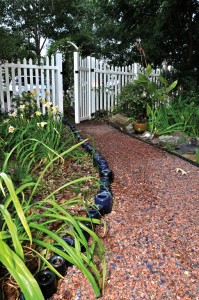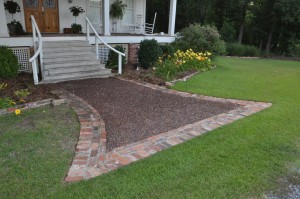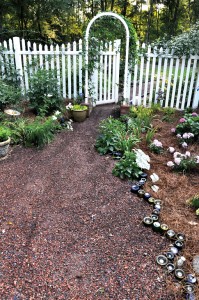Creating a garden path
Posted on July 3, 2011 by bob in Yard 'N Garden
What can you do in the yard when the temperature’s in the 90’s and there’s no rain in sight? Create a pathway! A path from the gate to the patio or the vegetable garden can be installed in the summer. Pathways, while functional, also add interest to your yard and reduce the amount of grass area.
Building materials vary in cost and appearance, with a wide variety of options to choose from. One pathway can use mulch while another can be constructed with stone or brick. No matter what the surface some basics apply. Where will the path go? How will it be used? These questions must be answered early in your project. Will it be used solely for walking? Or will the lawn mower or wheel barrow need to travel on the path? These answers affect the surface you choose and the width required.
Once you determine the location and width of the path, it’s time to lay it out. Keep your proportions in mind when laying out the path. This is the time to take measurements. The square footage will determine the amount of materials needed. Use a garden hose to lay out the design of the path. Remember, a few curves add charm!
After the shape is determined, leave the hose in place and spray paint the ground to create one side of the path.
Next, take a stick or board the width of the path, lay it perpendicular to the painted line, and spray a dot at the opposite end. Pick it up, place it one foot below where it was, spray another dot, and repeat this process at one foot intervals. Connect the dots and presto, you have the pattern painted out. Measure this length and multiply by two for the edging needed. Take the length and multiply it by the width for your square footage total. Save these numbers. You’ll need them to know the amount of construction material to purchase. NOTE: You only want the path to be 1/2” deep. When ordering gravel, the biggest mistake most people make is ordering more than needed. That’s why measuring is so important. Gravel is sold by the yard. The gravel material companies will work with you to sell you the correct amount.
Keep the style of your home in mind when picking path materials. For example, a formal colonial style home might look best with a brick path, while a casual home could use gravel or mulch. Many options are available: brick, stone, (flagstone and slate), tile, stamped concrete, concrete pavers, crushed rock, gravel. (If choosing gravel, use #8910. It’s small and easy to walk on. To add some jazz to the gravel, tumbled glass pebbles can be mixed in. They add color, too.) Bark, wood chips, pecan shells, pine straw and natural materials that must be replaced over time will be the least expensive materials.
Edging for a path could be steel, wood, or recycled plastic lumber. All of these provide super edging to hold in small materials. Brick looks great and should be placed about 1/3 of the way in the soil to keep it from shifting. Stone and cobblestones are very handsome as well, though more costly. Be creative. I built a pathway using wine bottles to edge the path. They were free (after somebody drank the wine), charming, and interesting, buried at different heights, next to each other. Mixing glass pebbles with the gravel for this walk teamed up for a fabulous look.
I once created another “no purchase” path by using a tree that had been cut and left in the yard. I sliced it into 3” rounds (using a chainsaw to cut the circles), and placed the circular pieces in the center of mulch. The circles provided a hard surface to walk on.
Once you settle on your shape, the path needs to be leveled. After your edging is in place, add a layer of sand as the base to level your surface. Next, put down roofing felt to keep the weeds out, then place your construction material (brick, bark, stone, etc.) on top of the felt. Voila! You’re done!
It’s hot and dry outside, so tackle a project that requires no water and adds a beautiful landscaped element to your yard. Happy trails (and pathways) to you!
Ethel Dozier Boykin, a Montgomery native, owns Art in the Garden, a landscape design and consulting company in the Capital City. Contact her at 334-395-5949, or by e-mail at etheldozierboykin@yahoo.com.













